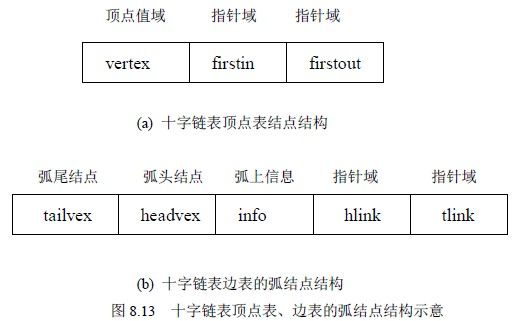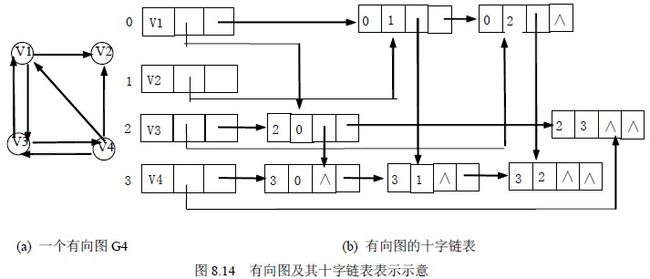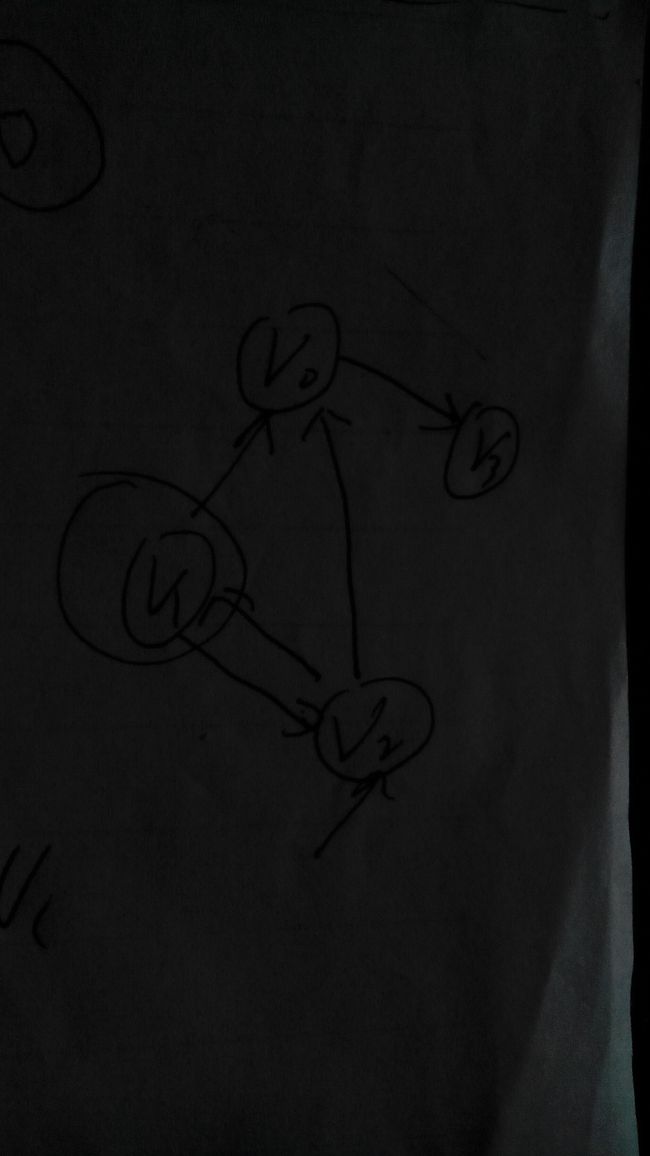数据结构之图的十字链表表示法
上篇博客介绍了图的邻接表表示法(图的邻接表表示法) 然而,对于有向图来说,邻接表是有缺陷的。关心了出度问题,想了解入度就必须要遍历整个图才可以,反之,逆邻接表解决了入度却不了解出度的情况。有没有可能把邻接表与逆邻接表结合起来呢? 答案是肯定的,就是把 它 们整合在一起。这就是我们现在要讲的有向图的 一种存储方法: 十字链表(Orthogonal List) 。
十字链表的数据存储结构如下(图来自c语言中文网):
#define MAX_VERTEX_NUM 20
typedef int VertexType;
//图的种类包括有向图/有向网
typedef enum {DG,DN} GraphKind;
typedef struct ArcBox {
int tailvex; //该弧的尾顶点的位置
int headvex; //该弧的头顶点的位置
struct ArcBox *hlink; //指向下一个起点相同的弧
struct ArcBox *tlink; //指向一个终点相同的弧
int weight; //弧的权值
}ArcBox;
typedef struct VexNode{
VertexType data;
ArcBox *firstin; //指向该顶点的第一条入弧
ArcBox *firstout; //指向该顶点的第一条出弧
}VexNode;
typedef struct {
VexNode xlist[MAX_VERTEX_NUM];
int vexnum; //顶点数
int arcnum; //弧数
GraphKind kind; //图的种类(有向图/有向网)
}OLGraph;
头文件:olgraph.h
/*----------------------------------------------------------------------------
* file: algraph.h
* date:10-11-2014
* author:[email protected]
* version:1.0
* description:十字链表实现图的基本操作
* more:十字链表仅仅能表述有向图/网
-----------------------------------------------------------------------------*/
#define TRUE 1
#define FALSE 0
#define OK 1
#define ERROR 0
#define OVERFLOW -2
#define MAX_VERTEX_NUM 20
typedef int Status;
typedef int VertexType;
//图的种类包括有向图/有向网
typedef enum {DG,DN} GraphKind;
typedef struct ArcBox {
int tailvex; //该弧的尾顶点的位置
int headvex; //该弧的头顶点的位置
struct ArcBox *hlink; //指向下一个起点相同的弧
struct ArcBox *tlink; //指向一个终点相同的弧
int weight; //弧的权值
}ArcBox;
typedef struct VexNode{
VertexType data;
ArcBox *firstin; //指向该顶点的第一条入弧
ArcBox *firstout; //指向该顶点的第一条出弧
}VexNode;
typedef struct {
VexNode xlist[MAX_VERTEX_NUM];
int vexnum; //顶点数
int arcnum; //弧数
GraphKind kind; //图的种类(有向图/有向网)
}OLGraph;
//访问标记数组
int visited[MAX_VERTEX_NUM];
//创建图(有向图/有向网)
Status CreateGraph(OLGraph *G);
//定位顶点值v的位置,无则返回-1
int LocateVex(OLGraph G,VertexType v);
//销毁图
void DestoryGraph(OLGraph *G);
//返回顶点v的值
VertexType GetVex(OLGraph G,int v);
//对值为v的顶点赋值为value
Status PutVex(OLGraph *G,VertexType v,VertexType value);
//获取v的下一个邻接点的序号
int FirstAdjVex(OLGraph G,VertexType v);
//返回顶点v相对于w的下一个邻接点的序号
int NextAdjVex(OLGraph G,VertexType v,VertexType w);
//添加一个值为v的顶点
Status InsertVex(OLGraph *G,VertexType v);
//插入一段弧
Status InsertArc(OLGraph *G,VertexType v,VertexType w);
//删除一个顶点和相关的弧
Status DeleVex(OLGraph *G,VertexType v);
//删除一段弧
Status DeleArc(OLGraph *G,VertexType v,VertexType w);
//深度优先遍历
Status DFSTraverse(OLGraph G,Status (*Visit) (VertexType));
//深度优先递归遍历
void DFS(OLGraph G,int i,Status (*Visit) (VertexType));
//广度优先遍历
Status BFSTraverse(OLGraph G,Status (*Visit) (VertexType));
//打印元素
Status PrintElem(VertexType elem);
主程序:OLGraph.c
/*----------------------------------------------------------------------------
* file: OLGraph.c
* date:10-11-2014
* author:[email protected]
* version:1.0
* description:十字链表实现图的基本操作
* more:十字链表仅仅能表述有向图/网,
还有在遍历等操作时,沿着出
-----------------------------------------------------------------------------*/
#include
#include
#include "olgraph.h"
#include "linkqueue.h"
/*
* @description:创建图
*/
Status CreateGraph(OLGraph *G) {
int i,j,w,k;
VertexType tv,hv;
ArcBox *p;
//确定图的种类
printf("please enter the kind of graph(DG:0,DN:1):");
scanf("%d",&(*G).kind);
//确定顶点数和弧数
printf("please enter the vexnum and arcnum:");
scanf("%d,%d",&(*G).vexnum,&(*G).arcnum);
//确定各个顶点
printf("please enter each value of graph:");
for(i = 0; i < (*G).vexnum ; i++) {
scanf("%d,",&(*G).xlist[i].data);
(*G).xlist[i].firstin = NULL;
(*G).xlist[i].firstout = NULL;
}
//建立各个顶点间关系,即建立入/出表
if((*G).kind == DN)
printf("please enter the heads,tails and weights:\n");
else
printf("please enter the heads and tails:\n");
for(k = 0;k < (*G).arcnum ; k++) {
if((*G).kind == DN)
scanf("%d,%d,%d",&tv,&hv,&w);
else
scanf("%d,%d",&tv,&hv);
i = LocateVex(*G,tv); //弧尾
j = LocateVex(*G,hv); //弧头
p = (ArcBox *) malloc(sizeof(struct ArcBox));
if(!p)
exit(OVERFLOW);
p->tailvex = i; //弧的起点 -->入表
p->headvex = j; //弧的终点 -->出表
p->hlink = (*G).xlist[j].firstin; //指向下一个起点相同的弧节点
p->tlink = (*G).xlist[i].firstout; //指向下一个终点相同的弧节点
//注意不管是出还是入表都是在表头插入的,中表示v1有出,v2有入
(*G).xlist[i].firstout = (*G).xlist[j].firstin = p;
if((*G).kind == DN)
p->weight = w;
}
return OK;
}
/*
* @description:定位顶点值v的位置,无则返回-1
*/
int LocateVex(OLGraph G,VertexType v) {
int i;
for(i = 0; i < G.vexnum ; i++)
if( G.xlist[i].data == v)
return i;
return -1;
}
/*
* @description:销毁图
* @more:遍历或是销毁等等一个思路可以仅仅按照出表来进行
*/
void DestoryGraph(OLGraph *G) {
ArcBox *p,*pre;
int i;
for(i = 0;i < (*G).vexnum ; i++) {
p = (*G).xlist[i].firstout; //找到每个顶点向量对应的十字链表
while(p) {
pre = p;
p = p->tlink;
free(pre);
}
}
}
/*
* @description:返回顶点v的值
*/
VertexType GetVex(OLGraph G,int v) {
if(v > G.vexnum || v < 0 )
exit(OVERFLOW);
return G.xlist[v].data;
}
/*
* @description:对值为v的顶点赋值为value
*/
Status PutVex(OLGraph *G,VertexType v,VertexType value) {
int i;
i = LocateVex(*G,v);
if( i < 0)
return ERROR;
(*G).xlist[i].data = value;
return OK;
}
/*
* @description:返回顶点值为v的下一个邻接顶点的序号
* @more:这里的第一个邻接顶点理解为顶点对应链表中的第一个节点
*/
int FirstAdjVex(OLGraph G,VertexType v) {
int i;
i = LocateVex(G,v);
if( i < 0)
return -1;
if(G.xlist[i].firstout)
return G.xlist[i].firstout->headvex;
return -1;
}
/*
* @description:返回顶点为v相对顶点值为w的下一个邻接顶点的序号,w为v的一个邻接顶点
*/
int NextAdjVex(OLGraph G,VertexType v,VertexType w) {
int i,j;
ArcBox *p;
i = LocateVex(G,v);
j = LocateVex(G,w);
if(i < 0 || j < 0 )
return -1;
p = G.xlist[i].firstout; //顶点v对应的弧链表
while(p && p->headvex != j)
p = p->tlink;
while(p && p->headvex == j) {
p = p->tlink;
if(p)
return p->headvex;
}
return -1;
}
/*
* @description:添加一个顶点值为v
* @more:注意这里不处理边
*/
Status InsertVex(OLGraph *G,VertexType v) {
int i;
i = (*G).vexnum;
(*G).xlist[i].data = v;
(*G).xlist[i].firstin = NULL;
(*G).xlist[i].firstout = NULL;
(*G).vexnum++;
return OK;
}
/*
* @description:删除一个顶点值为v的顶点,并删除相关的弧
* @more:这里的删除在于出表和入表是交叉的同时可能还要更新其他顶点的firstin等指针
* 思路和邻接表中的不同的是这里不能先进行顶点向量的更新,那样无法找到对应的出/入指针
* 顶点向量的更新应该放在最后面
* 关于十字交叉的出入表的处理思路如下:
* 1.顶点v的出弧也是其他顶点的入弧,故要改变其他顶点的出弧指针(仅仅改变),整个出弧直接删除
* 2.顶点v的入弧也是其他顶点的出弧,故要改变其他顶点的入弧指针(仅仅改变),整个入弧直接删除
* 3.更新向量数组,将数组元素上移动
* 4.更新相应节点的headvex和tailvex
*/
Status DeleVex(OLGraph *G,VertexType v) {
int k,j;
ArcBox *p,*pre;
k = LocateVex(*G,v);
if(k < 0)
return ERROR;
//顶点v的出弧也是其他顶点的入弧,调整其他顶点的入弧指针
for(j = 0; j < (*G).vexnum ; j++) {
if(j == k)
continue;
p = (*G).xlist[j].firstin;
//注意这里仅仅是调整,不涉及释放空间,释放的操作在随后的出弧处理中进行
while(p) {
//如果是第一个节点
if(p->tailvex == k && p == (*G).xlist[j].firstin) {
(*G).xlist[j].firstin = p->hlink;
break;
}
//没有找到相应的节点
else if(p->tailvex != k) {
pre = p;
p = p->hlink;
}
//不是第一个节点
else {
pre->hlink = p->hlink;
break;
}
}
}
//删除整个出弧链表
p = (*G).xlist[k].firstout;
while(p) {
pre = p->tlink;
free(p);
p = pre;
//边数减
(*G).arcnum--;
}
//顶点v的入弧同时也是其他顶点的出弧
for(j = 0; j < (*G).vexnum ;j++) {
if(j == k)
continue;
p = (*G).xlist[j].firstout;
while(p) {
//入表中的第一个节点
if(p->headvex == k && (*G).xlist[j].firstout == p) {
(*G).xlist[j].firstout = p->tlink;
break;
}
else if(p->headvex != k) {
pre = p;
p = p->tlink;
}
else {
pre->tlink = p->tlink;
break;
}
}
}
//删除顶点对应的整个入表
p = (*G).xlist[k].firstin;
while(p){
pre = p->hlink;
free(pre);
p = pre;
//边数减
(*G).arcnum--;
}
//顶点向量数组上移动
for(j = k + 1;j < (*G).vexnum; j++)
(*G).xlist[j - 1] = (*G).xlist[j];
//更新相应节点的headvex和tailvex
for(j = 0; j < (*G).vexnum ;j++) {
//处理出表
p = (*G).xlist[j].firstout;
while(p) {
if(p->headvex > k)
p->headvex--;
if(p->tailvex > k)
p->tailvex--;
p = p->tlink;
}
}
(*G).vexnum--;
return OK;
}
/*
* @description:在顶点值v和顶点值w间添加一段弧
*/
Status InsertArc(OLGraph *G,VertexType v,VertexType w) {
int i,j;
ArcBox *p;
i = LocateVex(*G,v); //弧尾
j = LocateVex(*G,w); //弧头
if(i < 0 || j < 0)
return ERROR;
p = (ArcBox *) malloc(sizeof(struct ArcBox));
if(!p)
exit(OVERFLOW);
p->tailvex = i; //弧的起点 -->入表
p->headvex = j; //弧的终点 -->出表
p->tlink = (*G).xlist[j].firstin; //指向下一个起点相同的弧节点
p->hlink = (*G).xlist[i].firstout; //指向下一个终点相同的弧节点
//注意不管是出还是入表都是在表头插入的,中表示v1有出,v2有入
(*G).xlist[i].firstout = (*G).xlist[j].firstin = p;
if((*G).kind == DN) {
printf("please enter the weight:");
scanf("%d",&p->weight);
}
return OK;
}
/*
* @description:删除顶点值w和顶点值v间的一段弧
*/
Status DeleArc(OLGraph *G,VertexType v,VertexType w) {
int i,j;
ArcBox *p,*pre;
i = LocateVex(*G,v);
j = LocateVex(*G,w);
if(i < 0 || j < 0)
return ERROR;
//这里需要删除一个节点,调整一个指针,因为v是w的起点则w是v的终点
//首先出
p = (*G).xlist[i].firstout;
if(p && p->headvex == j)
(*G).xlist[i].firstout = p->tlink;
else {
//往后一直找
while(p && p->headvex != j) {
pre = p;
p = p->tlink;
}
//找到了,且没有到最后
if(p)
pre->tlink = p->tlink;
}
//处理入
p = (*G).xlist[j].firstin;
//如果需要处理的是第一个节点
if(p && p->tailvex == i)
(*G).xlist[j].firstin = p->hlink;
else {
while(p && p->tailvex != i) {
pre = p;
p = p->hlink;
}
if(p)
pre->hlink = pre->hlink;
}
free(p);
(*G).arcnum--;
return OK;
}
/*
* @description:深度优先遍历图
*/
Status DFSTraverse(OLGraph G,Status (*Visit) (VertexType)) {
int i;
//重新初始化访问标记数组
for(i = 0; i < G.vexnum; i++)
visited[i] = FALSE;
//保证每个顶点都能被访问到
for(i = 0; i < G.vexnum ; i++)
if(!visited[i])
DFS(G,i,Visit);
return OK;
}
/*
* @description:深度优先递归遍历邻接点
*/
void DFS(OLGraph G,int i,Status (*Visit) (VertexType)) {
ArcBox *p;
Visit(G.xlist[i].data);
visited[i] = TRUE;
p = G.xlist[i].firstout; //出表第一个节点指针
while(p && visited[p->headvex]) //如果出表中当前节点已经被访问则往下找终点相同的点
p = p->tlink;
if(p && !visited[p->headvex])
DFS(G,p->headvex,Visit);
}
/*
* @description:广度优先遍历图
*/
Status BFSTraverse(OLGraph G,Status (*Visit) (VertexType)) {
LinkQueue Q;
int i,v,w;
InitQueue(&Q);
//重新初始化访问标记数组
for(i = 0;i < G.vexnum; i++)
visited[i] = FALSE;
//外层循环保证每个节点都能访问到
for(i = 0;i < G.vexnum ; i++) {
if(!visited[i]) {
Visit(G.xlist[i].data);
visited[i] = TRUE;
EnQueue(&Q,i);
while(!QueueEmpty(Q)) {
DeQueue(&Q,&v);
for(w = FirstAdjVex(G,GetVex(G,v)); w >= 0; w = NextAdjVex(G,GetVex(G,v),GetVex(G,w)) ) {
if(!visited[w]) {
Visit(G.xlist[w].data);
visited[w] = TRUE;
EnQueue(&Q,w);
}
}
}
}
}
return OK;
}
/*
* @description:打印元素
*/
Status PrintElem(VertexType elem) {
printf("%d",elem);
return OK;
} 测试文件:test.c
/*----------------------------------------------------------------------------
* file: test.c --> test file for OLGraph
* date:10-11-2014
* author:[email protected]
* version:1.0
* description:十字链表实现图的基本操作
* more:十字链表仅仅能表述有向图/网,由于没有进行输入检测,在输入前
应该想好结构,所有程序亲测
-----------------------------------------------------------------------------*/
#include
#include "olgraph.h"
void main() {
OLGraph G;
//创建图
CreateGraph(&G);
//广度优先遍历
BFSTraverse(G,PrintElem);
printf("\n");
/*
please enter the kind of graph(DG:0,DN:1):0
please enter the vexnum and arcnum:4,5
please enter each value of graph:0,1,2,3,
please enter the heads and tails:
0,3
1,2
2,1
2,0
1,0
0312
*/
} 测试对应的图:
完整的代码看:GitHub



